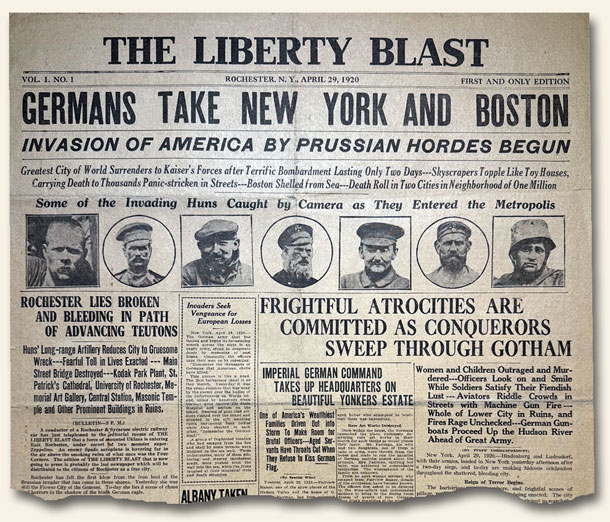Lead-up to a Nation… as reported in the newspapers of the day (November, 1775)…
December 5, 2025 by GuyHeilenman · Leave a Comment

Continental Currency – No Power to Tax or Regulate (Lead-up to a Nation – E14)
League of Friendship-Articles of Confederation Underscored National Power (Lead-up to a Nation-E15)
James Rivington – From Impartial to Loyalist (Lead-up to a Nation – E16)
The Liberty Bell – Proclaim Liberty Through the Land (Lead-up to a Nation – E17)
We hope you are enjoying this year-long trek to the 250th anniversary of The United States through the eyes of those who were fully engaged, first hand. As mentioned previously, all accounts are rooted in what they read in the newspapers of the day.
“History is never more fascinating than when read from the day it was first reported.” (Timothy Hughes, 1975)
From Passion to Legacy: 50 Years Strong… and Counting…
November 28, 2025 by GuyHeilenman · 10 Comments
The following, penned by the founder of Timothy Hughes Rare & Early Newspapers, appeared on the front page of our most recent catalog (#361):
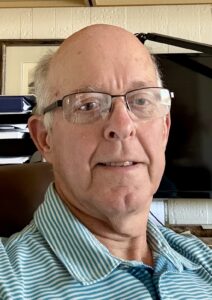
It was 50 years ago this month that the Rare & Early Newspapers business began.
Having been a collector of many things in my earliest of years, primarily coins, venturing into this fascinating world of old newspapers was a logical step. I never really saw a truly old newspaper until I stumbled across an 1826 Philadelphia newspaper at a local flea market, I was convinced I had discovered an unexploited hobby. So my new adventure began.
Although I started collecting somewhat earlier, I sold my first newspaper on December 1, 1975. I used a manual typewriter to list various newspapers on a legal-size sheet of paper, then making photocopies at a local college to print multiple sheets. When an issue or two sold, I typed up replacements and taped the listings over those that sold, then made more photocopies.
How to advertise in the pre-internet era? I would place small, classified ads in various history & collector-themed magazines. As for research, I kept a set of encyclopedias next to my desk.
Eventually, the single sheets of offerings turned into small catalogs. The first formal catalog was issued in the spring of 1978 and wasn’t even numbered, as I wasn’t sure there would be another.
This catalog you have in your hands is number 361. My ad mentioned “…send 25¢…” for the catalog, which more than covered the cost of postage. Imagine that!
It was always my goal to continue to offer more issues, earlier issues, and more historic offerings with each passing month. I’ve been pleased with our progress, and for those who have been with us for many years, hopefully you’ve noticed the dramatic growth in the range of our inventory. It was my hope that collectors would look forward to each catalog, anxious to discover new “goodies” we’ve not offered before.
I became semi-retired some 23 years ago with Guy Heilenman taking over, but I remain actively involved, primarily with buying inventory. My wife and I moved West to be close to family, but I get back to Williamsport for “hands-on” work about six weeks a year.
There will be no end to this business. We remain the only full-time dealers in early newspapers in the world. At some point another generation will take over, and our inventory and offerings will, hopefully, continue to expand. I hope to remain involved for as long as God allows.
Thank you all for 50 years of fun!
Tim Hughes
Properly Directed Thankfulness – George Washington and the Foundations of a New Nation…
November 25, 2025 by GuyHeilenman · Leave a Comment
On October 3, 1789, just months into his presidency, George Washington issued the very first official presidential proclamation. Fittingly, his choice of subject set the tone for a new nation: a call for a national day of thanksgiving and prayer. In it, Washington urged the people of the United States to acknowledge “with grateful hearts the many signal favors of Almighty God, especially by affording them an opportunity peaceably to establish a form of government for their safety and happiness.” This was more than a holiday declaration—it was a reminder that gratitude, humility, and faith would form part of the nation’s foundation.
Below is the complete text of Washington’s Thanksgiving Proclamation as it appeared on the front page of the Gazette of the United States on October 7, 1789:

Who’s Who in Newspapers – John Wanamaker edition
November 10, 2025 by GuyHeilenman · 1 Comment
Typically, our “Who’s Who in Newspapers” series highlights individuals who were unfamiliar to me before I delved into the world of Rare & Early Newspapers. Today’s post is a departure from that norm. While reviewing the December 12, 1922, issue of The Bethlehem Times, I came across a front-page report of John Wanamaker’s passing. The article stirred a flood of childhood memories tied to this remarkable man whose legacy left a lasting impression on me. Eager to share his story, I hope the following introduction sheds light on his extraordinary contributions.
John Wanamaker: The Merchant Who Made Shopping an Experience
 From personal memories to retail innovation, Wanamaker’s left a legacy that reshaped both commerce and tradition. Every December starting in the mid-1950s, my parents bundled up my siblings and me for a trip into Philadelphia to see the Christmas light and music show at Wanamaker’s (currently being converted into a mixed-use facility). To us, it was pure magic — thousands of twinkling lights, the sound of the great pipe organ, and crowds of families gathered in awe. With my grandmother working in the store during those years, Wanamaker’s always felt like more than a department store — it felt like part of our family’s story.
From personal memories to retail innovation, Wanamaker’s left a legacy that reshaped both commerce and tradition. Every December starting in the mid-1950s, my parents bundled up my siblings and me for a trip into Philadelphia to see the Christmas light and music show at Wanamaker’s (currently being converted into a mixed-use facility). To us, it was pure magic — thousands of twinkling lights, the sound of the great pipe organ, and crowds of families gathered in awe. With my grandmother working in the store during those years, Wanamaker’s always felt like more than a department store — it felt like part of our family’s story.
That sense of wonder was no accident. John Wanamaker (1838–1922), the man behind the store, believed shopping could be more than a transaction — it could be an experience. When he opened his Philadelphia department store in 1876, it quickly became a model for modern retail. Wanamaker pioneered the one-price system (no haggling), introduced the money-back guarantee, and used newspaper advertising on a scale few had seen before.
He also reshaped how Americans paid for what they bought. Realizing that many working families couldn’t afford to pay cash for larger purchases, Wanamaker offered installment plans and charge accounts. This bold move laid the foundation for consumer credit, opening the door for more households to access quality goods.
Beyond retail, Wanamaker served as U.S. Postmaster General under President Benjamin Harrison, introducing commemorative stamps and expanding rural mail delivery. Yet it was his Philadelphia store — both marketplace and civic landmark — that became his greatest legacy.
Even today, the memory of standing with my siblings beneath the glow of the light show while the Wanamaker organ thundered through the Grand Court remains a vivid reminder of how one man’s vision reshaped not just shopping, but tradition itself.
Wanamaker’s Firsts – Innovations that reshaped retail
- One-Price System – Ended the practice of haggling; everyone paid the same fair price.
- Money-Back Guarantee – Built customer trust and loyalty.
- Large-Scale Advertising – One of the first to use newspapers to reach wide audiences.
- Department Store Experience – Turned shopping into a cultural outing with art, music, and public events.
- Consumer Credit – Introduced installment plans and charge accounts, paving the way for modern credit.
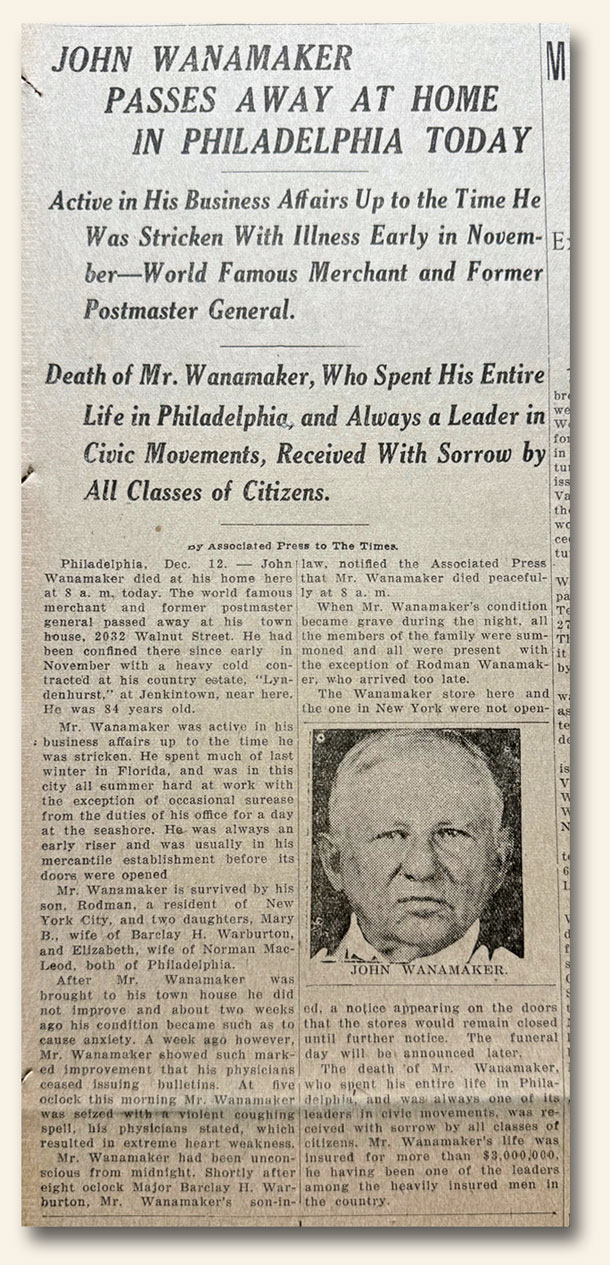
Lead-up to a Nation… as reported in the newspapers of the day (October, 1775)…
November 6, 2025 by GuyHeilenman · Leave a Comment

England Misses the Temper of the Times (Lead-up to a Nation – E9)
George Washington – Religious Freedom (Lead-up to a Nation – E10)
Ethan Allen and his Green Mountain Boys (Lead-up to a Nation – E11)
The Liberty Tree (Lead-up to a Nation – E12)
George Washington – Integrity, Leadership & Humility (Lead-up to a Nation – E13)
We hope you are enjoying this year-long trek to the 250th anniversary of The United States through the eyes of those who were fully engaged, first hand. As mentioned previously, all accounts are rooted in what they read in the newspapers of the day.
“History is never more fascinating than when read from the day it was first reported.” (Timothy Hughes, 1975)
The reason I collected it: the Nuremberg trials…
November 3, 2025 by TimHughes · Leave a Comment
I have likely stated several times that part of the quest in seeking the best report of a notable event is to find it in a newspaper as close to where it happened as possible. For the death of JFK, a Dallas newspaper is best. On the bombing of Pearl Harbor, a Honolulu newspaper is great. On the Boston Massacre in 1770, a Boston paper would be wonderful.
Some events can be extremely difficult, so you do the best you can. How about when man walked on the moon? Outside of a lunar publication that did not exist, a newspaper from Neil Armstrong’s hometown is pretty good. Or perhaps one from close to Cape Canaveral.
One of the more notable events at the conclusion of World War II was the Nuremberg Trials. There were 22 defendants held for war crimes; 12 would hang, 7 served time, and 3 found not guilty.
But finding a German newspaper with this report had eluded us. And as is the case with events in foreign language countries, a report close to the event would be diminished a bit if the text is in a language other than English. Not many desire a newspaper they cannot read.
But as luck would have it, a Nuremberg suburb–Furth–had a former Nazi air base, captured by American forces in early April, 1945 & converted to a U.S. air base. And better yet, it produced a small, obviously low-circulation newspaper called “The Jet Gazette”. The October 1, 1946 issue was devoted to the results of the trials. And being an American air base, it’s in English. It was a great find that I suspected never existed!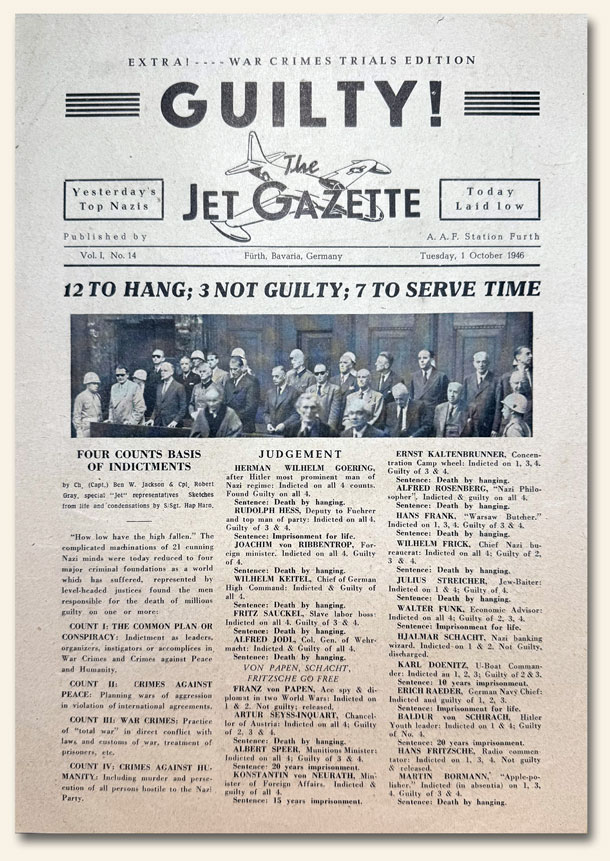
They Put It In Print – A U.S. President Seeks Permission…
October 27, 2025 by GuyHeilenman · Leave a Comment
In the U.S., only Congress can declare war. So how many wars have Americans actually fought since World War II? You might think of the Korean War, Vietnam, Kuwait, Iraq, or Afghanistan. But here’s the catch: the answer is technically zero.
How can that be? Modern presidents simply avoid the word “war,” using terms like “military engagement” or “conflict” instead. No official declaration, no congressional vote—problem solved.
It wasn’t always this way. Take the War of 1812: President James Madison believed the U.S. needed to go to war with Great Britain. Did he send troops under a euphemism like “military operation”? No. He went straight to Congress with a detailed manifesto explaining why war was necessary. That document, printed in The War on June 27, 1812, shows just how seriously Madison took the Constitution’s war powers. The introduction and conclusion of his lengthy plea are shown below.
Today, renaming wars might serve convenience or strategy, but it raises a bigger question: if we can call war by any name we like, what happens to the checks and balances the Constitution set in place?
Do you think this trend is a necessary evolution—or a dangerous bypass of Congress?
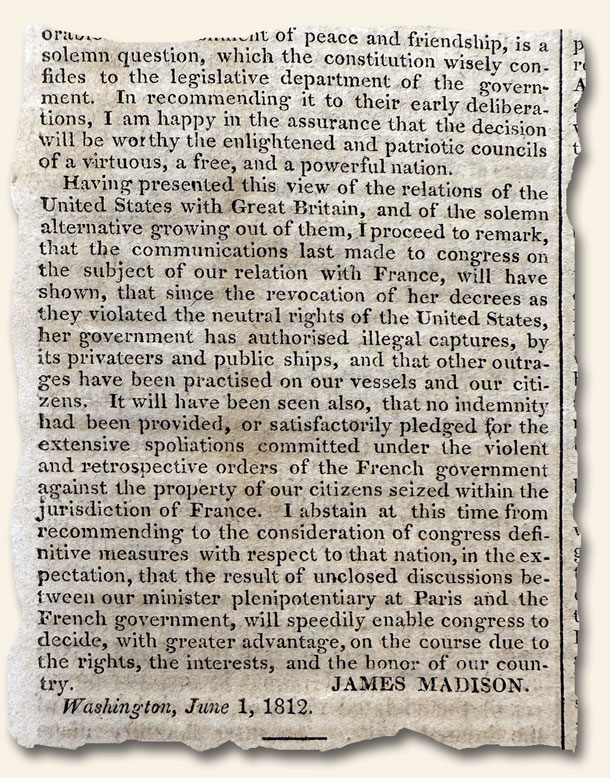
From the Vault: Headlines drive interest in World War II…
October 24, 2025 by TimHughes · Leave a Comment
For likely a multitude of reasons, interest in World War II newspapers ranks far higher than in the Korean War, World War I, or the Spanish-American War. It may be a generational thing, as most collectors today are children of World War II veterans and likely heard stories of the war first-hand, or found  newspapers in their parents attics which sparked an interest. One could debate a number of other possible reasons why other wars lack the intrigue found in that fought by the “greatest generation”.
newspapers in their parents attics which sparked an interest. One could debate a number of other possible reasons why other wars lack the intrigue found in that fought by the “greatest generation”.
Headline collecting has always been a focus for this hobby, and as any collector knows, bold, banner headlines did not become commonplace until late in the 19th century. With the increasing competitiveness of daily newspapers across the country–Hearst, Pulitzer & others rising to prominence–flashier front pages were needed to draw attention at the corner news stand. It’s a shame there is not more interest in the Spanish-American War and World War I as both events resulted in some huge, dramatic, & very displayable headlines.
Because there are a plethora of newspapers from the WWII era available, collectors have become very discriminating in what they collect. Only the “best of the best” will do, meaning just the major events and only those with huge and displayable headlines. If there is a “top 6” list of sought-after events, our experience is they would be: 1) attack on Pearl Harbor; 2) the D-Day invasion; 3) death of Hitler; 4) end of the war in Europe; 5) dropping of the atomic bomb; 6) end of the war in the Pacific. One could add any number of other battle reports such as Midway, battle of the Bulge, fall of Italy, Iwo Jima, battle for Berlin, and so much more. And we could step back before American involvement in the war and add Hitler’s invasion of Poland and the battle of Britain.
The bigger the headline the better. With some newspapers the entire front page was taken up with a headline and a related graphic. The U.S. flag was a common patriotic device. Tabloid-size newspapers commonly had the front page entirely taken up with a singular headline and tend to be better for display given their smaller size.
 And not just American newspapers draw interest. German newspapers hold a special intrigue, but the language barrier is a problem for many. But the British Channel Islands, located in the English Channel between England & France, were occupied by the Nazi during the war so their reports were very pro-Nazi while printed in the English language (ex., Guernsey Island). And the military newspaper “Stars and Stripes“, while certainly being American, was published at various locations in Europe and the Pacific. Collectors have a special interest in finding World War II events in the official newspapers of the American military forces. Plus there were a multitude of “camp” newspapers, amateur-looking newspapers printed on a mimeograph machine for consumption limited to a military base, and typically printed is very small quantities. Their rarity is not truly appreciated by many.
And not just American newspapers draw interest. German newspapers hold a special intrigue, but the language barrier is a problem for many. But the British Channel Islands, located in the English Channel between England & France, were occupied by the Nazi during the war so their reports were very pro-Nazi while printed in the English language (ex., Guernsey Island). And the military newspaper “Stars and Stripes“, while certainly being American, was published at various locations in Europe and the Pacific. Collectors have a special interest in finding World War II events in the official newspapers of the American military forces. Plus there were a multitude of “camp” newspapers, amateur-looking newspapers printed on a mimeograph machine for consumption limited to a military base, and typically printed is very small quantities. Their rarity is not truly appreciated by many.
For obvious reasons, there is also a high degree of collectible interest from those wishing to make sure certain aspects of history are not forgotten. The Holocaust, and the Nazi propaganda used to provide a rationale for eliminating the Jewish people, is well documented in newspapers from the era. In addition to the Holocaust and its atrocities, issues providing context through reporting other pre-war events such as the Great Depression, fascism, and increased militarism, are also desirable.
True to any collectable field, newspaper collectors are always on the lookout for an issue better than what they have, and collection upgrades are constant. Finding that special, rare, unusual or fascinating headline is what makes the hobby fun. Will interest in the Korean War and the Vietnam War gain more interest in future years? Perhaps so. With interest currently low and availability and prices very attractive, it might be a good time to explore.
The reason I collected it: a single-focus newspaper…
October 13, 2025 by TimHughes · 1 Comment
The general rule for a newspaper of any era is to report the news of the day on a regular basis, typically daily or weekly. Some have a thematic focus whether it be the slavery issue, the military, masonic events, etc., but even such newspapers maintained a history of publishing on a regular basis.
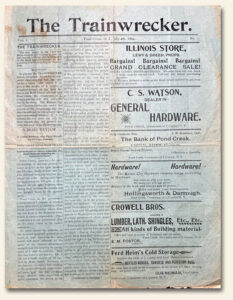 I don’t believe we have previously discovered a newspaper that had a singular focus on a specific event until we acquired “The Trainwrecker” from Pond Creek, Oklahoma Territory, 1894. This is not just a rare title; this could be a unique issue being the volume 1, number 1 issue of a newspaper about which nothing can be found. It is not listed in Gregory’s “Union List of Newspapers”, nor have we found anything on the internet.
I don’t believe we have previously discovered a newspaper that had a singular focus on a specific event until we acquired “The Trainwrecker” from Pond Creek, Oklahoma Territory, 1894. This is not just a rare title; this could be a unique issue being the volume 1, number 1 issue of a newspaper about which nothing can be found. It is not listed in Gregory’s “Union List of Newspapers”, nor have we found anything on the internet.
Its purpose is noted on the front page, and it seems to have a singular focus: the dispute the Pond Creek area had with the Rock Island Railroad.
As a bit of background, I might encourage a visit to “Hell on Rails: Oklahoma Towns at War with the Rock Island Railroad“, which details the backdrop for why this newspaper was created. It is rather convoluted and relates much to how the Indian Territory, now Oklahoma, was settled and how the railroads were a factor in town settlements.
The issue begins with: “The only paper in the Cherokee Strip capable and willing to take up and handle without gloves the action of the Rock Island Railroad, in the pursuance of their policy to rule or ruin.”
Then the “Salutary” begins: “In placing the TRAINWRECKER before the public, we ask for no sympathy–realizing full well the step we have taken. Our object is to give to the people of L county a complete account of the fight between the Rock Island railroad and Pond Creek, the county seat of L county and the only live, energetic city in the Strip…” with much more not just on the front page but on inside pages as well.
It is possible this newspaper existed for just this one issue, but without documenting records we cannot confirm. Printed as it is on green paper, it certainly doesn’t seem as though the publisher planned for a lengthy run.
This is part of the fascination with rare titles, as their scarcity simply implies a lack of information. Although we have encountered other newspapers that failed to exist beyond just a few issues, this is the first that seems to have existed to exploit a singular concern.
Personal note from Guy: “If historical fiction is within your wheelhouse of interests, I found ‘The Assassin’ and ‘The Wrecker’, both by Clive Cussler, fun reads. The former focuses more on the O.T. region (with a mention of some of the locations indicated above), while the latter zeros in on the sabotaging of trains during this era.”
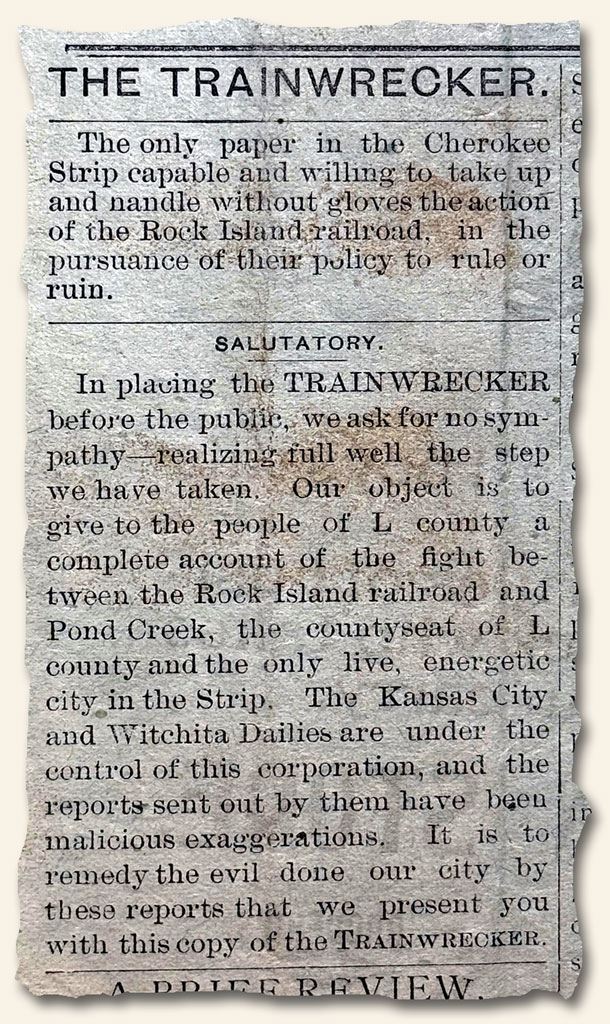
What if Germany won World War I ?
October 6, 2025 by TimHughes · Leave a Comment
Some of the more intriguing newspapers are “futuristic” editions, those printed with a dateline 50 or 75 years in the future, filled with reports of what editors presumed life would be like at that time. They always prove to be very interesting reading.
We recently came upon a “what if” newspaper. Although we’ve had a few, including use of the atomic bomb on American cities, or end-of-the-world scenarios, this issue of “The Liberty Blast” (shown below) is printed as if Germany had won World War I. Although the dateline reads “April 29, 1920”, the editorial on page 2 notes that it was published on April 29, 1918, before World War I had come to an end.
The reporting is fascinating. See the many photos for what the editors thought could have happened. The page 2 editorial in this edition–the first any only of this title–was meant to: “…awaken in the hearts and minds of those who read it a realization of those horrors of a great world war…near to American shores…”.
An interesting issue to read. One of the many treasures to be discovered in the pursuit of this fascinating hobby!